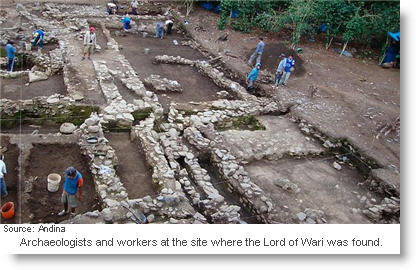— By Paul Goulder —
It is worth examining the significance of the discovery of the tomb of a Wari noble at the Espiritu Pampa archaeological site, an “aristocrat” who has been named variously Lord Vilca, Huari, Wari and (here) Vilcabamba. Journalists have a nose for the sensational, so it is not surprising that in Australia, for example, the Herald Sun should give significant coverage – as have newspapers around the world – to the discovery of a tomb thousands of miles away from Sydney, in the tropical cloud forest (ceja de selva) of Peru. The forest may be cloudy but with this find Peru’s history becomes that much clearer.
The tomb forms part of the (Vilcabamba) Espiritu Pampa archaeological site, above.
But why is it “sensational”? Every so often (and it seems with increasing frequency) there is a significant discovery – Machu Picchu, Chavín, Sipan, Caral, Vilcabamba – which lifts our appreciation of Peru’s past to new levels. Let’s consult the gurus.
Luis Lumbreras, distinguished archaeologist, author and ex-director of the National Cultural Institute, is quoted as saying, ‘It is a spectacular, truly surprising discovery that will make us revise part of Inca history. It is the first proof of Wari presence in the jungle, and proof that the Waris were in the area much earlier than the Incas. I would not be surprised if archaeologists now uncover a Wari city in the area.” (Wari and Huari are used interchangeably).
Two distinguished linguists on Peru, César Itier (INALCO, Paris) and Rodolfo Cerrón Palomino (Universidad Católica, Lima) have for long been explaining that Cusco was in all probability Aymara-speaking (and therefore Wari).
Given that the Wari were strongly interconnected with the Tiawanaku Culture (their capital city near the shores of Lake Titicaca is passed on the road from Puno to La Paz), there is now a strong suspicion that the Inca Empire owed much more to the Wari-Tiawanaku expansion than was previously thought. Some specialists had been saying so all along.
The Ministry of Culture – the former National Institute of Culture– in Cusco was quick to mount a display of gold and silver pieces of the pre-Inca Lord Vilca / Vilcabamba / Huari. The funded archaeological exploration began in July 2010 and was long overdue.
John Hemming, in his book “The Conquest of the Incas” over 40 years ago (1970), had opened up South American explorers’ appetites for “going beyond” Machu Picchu into the Vilcabamba. That same year, Gene Savoy had published the more specialized Vilcabamba: last city of the Incas, after a series of earlier articles in the Peruvian Times (see LOOKING BACK: Discovery of Vilcabamba, Last Refuge of the Incas).
Over the years getting to Espiritu Pampa in the Vilcabamba became a type of Holy Grail with hand-copied versions of John Hemming’s description being passed between successive waves of travelers in the hostals of Cusco. So it is no doubt with great delight that these now, many thousands of amateur (pre)historians will be able to read that the Vilca-valley is every bit as important as they may have thought.
“An Inca account of the Conquest of Peru” (several translations and edits) by Diego de Castro Yupangui (Titu Cusi) was a spirited account and defense of the Inca’s handling of the Spanish invasion, or “arrival” as it has been put. It was written by the penultimate Inca from the last Incan redoubt, Vilcabamba, following the fall of Cusco and the subsequent rebellion.
Titu Cusi has become a second “Huaman Poma” for those searching for an indigenous view of the Spanish invasion and conquest. If Machu Picchu was ever the lost city of the Incas then Vilcabamba (Espiritu Pampa) is the last city to remain in the autonomous control of an Inca. It was here that the very last Inca, Tupac Amaru I, was hunted down before being taken to Cusco for execution. It is not inappropriate that it is here that archaeologists have found a Wari lord – a find that may force a reinterpretation of this part of Peru’s history.
But a word of caution is necessary. Archaeological finds are often over-hyped at first, so stand back a while for the specialists to pass through an international conference or two and for some form of consensus to emerge.
UPDATE: The minister of Culture, Juan Ossio, announced this week that a call will be made in mid-March to invite 30 Peruvian and foreign specialists to form a multi-disciplinary study on the finds of the Lord of Wari at Espiritu Pampa in Vilcabamba. The invitation includes Luis Lumbreras, former head of the National Culture Institute and a former director of the National Archaeology and Anthropology Museum, as well as Dr. Alan Kolata, anthropologist at the University of Chicago whose expertise lies in the Tiwanaku civilization of Lake Titicaca and the Aymara.






